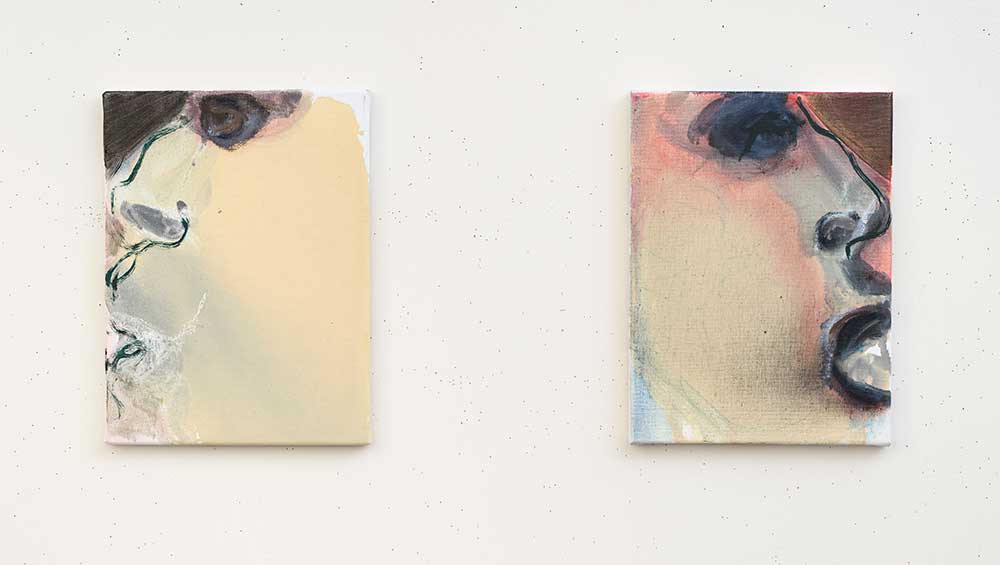
Marlene Dumas. The Enemy, 2018-2024. Oil on canvas, diptych, 40 x 30 cm (15 3/4 x 11 3/4 in) each. Courtesy the artist and Frith Street Gallery, London. Photo: Peter Cox.
Frith Street Gallery, London
20 September – 16 November 2024
by HATTY NESTOR
Historically, portraits have been visual depictions of status and prestige, representations created to mark power and authority. They are a way of capturing the characteristics and individual persona of a subject, but also give an interpretation on behalf of the artist. In this sense, they act as a window into the feelings, moods and individual attributes of the subject, at the same time encapsulating a moment in time of the subject’s life, their historical context and location. But in every portrait and portrayal, there is also the artist’s interpretation and style, which influence how, and why, certain subjects are captured and in what light.
Several artists have mastered the medium of portraiture while also creating a unique aestheticisation of the human figure. I first came across the work of the South African artist Marlene Dumas (b1953) several years ago while researching painters who capture celebrities and well-known cultural figures from images in the media, alongside archival material, and photographs by friends and family. Haunting portraits of Amy Winehouse, Phil Spector and even Christ on the crucifix have led to international renown for Dumas. The tension between private and public selfhood underpins her work, where her fluid, gestural portraits prompt the viewer to consider how to look at and interpret how others are witnessed and perceived. Also returning to how we look and embodiment, Dumas reorients our attention to our own bodies, in subtle and profound ways, through her use of oil and ink on canvas.
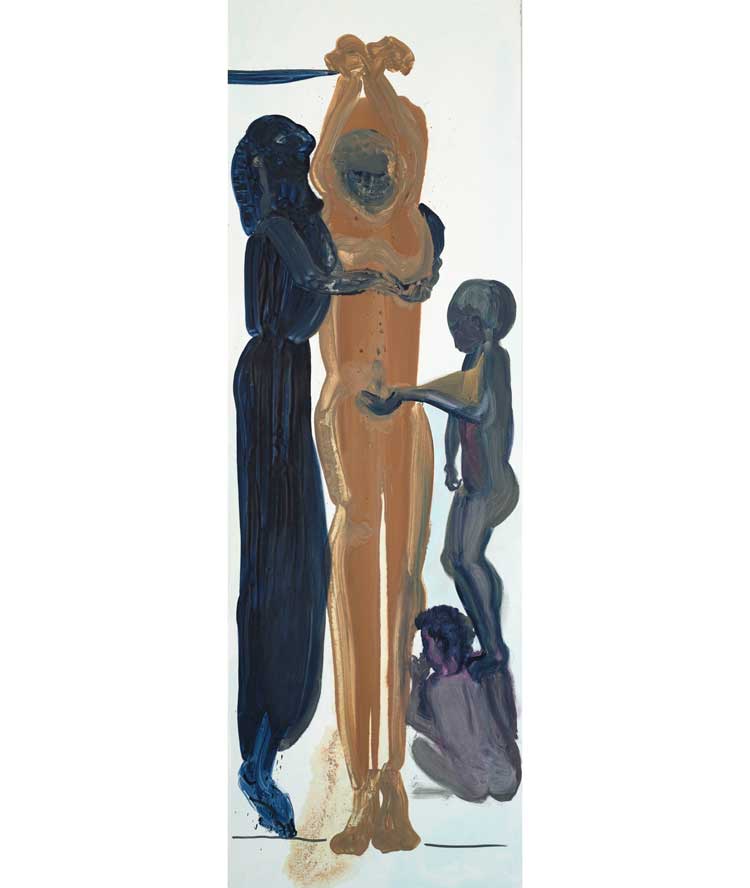
Marlene Dumas. Mourning Marsyas, 2024. Oil on canvas, 300 x 100 cm (118 1⁄8 x 39 3⁄8 in). Courtesy the artist and Frith Street Gallery, London. Photo: Peter Cox.
Dumas, whose career began in the 1970s, has lived and worked in Amsterdam since 1976 and began exhibiting internationally in 1978. Her latest show, at Frith Street Gallery in London, has 18 works, spanning the last two decades, including a new painting titled Mourning Marsyas, from which the exhibition takes its title. Ancient parables underpin and inspire Dumas’s painting. Mourning Marsyas was inspired by book six of Metamorphoses, in which Ovid tells the story of the satyr Marsyas who challenged the god Apollo to a musical competition. It was to be judged by the Muses, and the winner could treat the loser in any way he wished. Apollo triumphed and skinned Marsyas alive. To Dumas, Apollo represents revenge and dominance, while Marsyas represents liberty and uncovering the evils of power. This binary runs through the exhibition, where ethical sentiments of vulnerability, displacement and grief inform each painting, personally and politically. Through these uncanny and melancholic depictions, with their eerie faces painted in loose brush strokes, Dumas invites us to ponder the complexities of life.
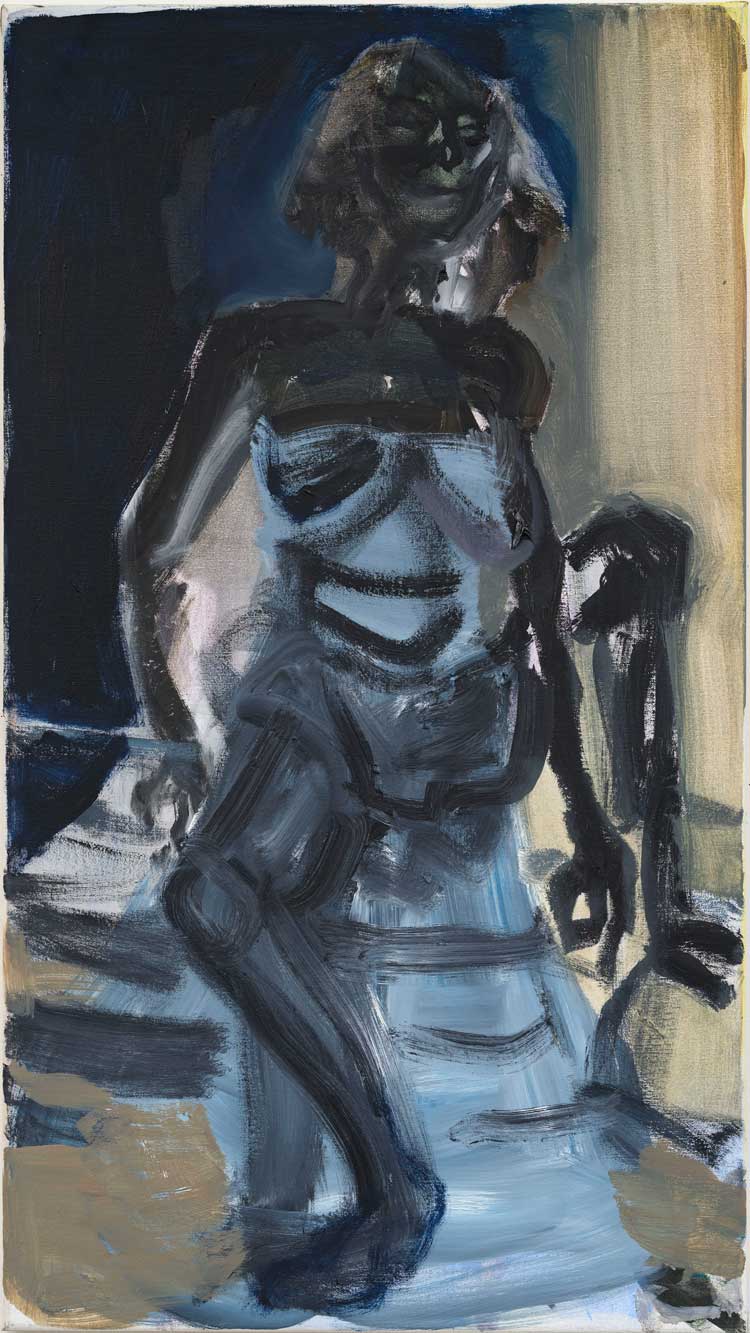
Marlene Dumas. Fate, 2000-2024. Oil on canvas, 100 x 56 x 3 cm (39 3/8 x 22 x 1 1/8 in). Courtesy the artist and Frith Street Gallery, London. Photo: Peter Cox.
The universal and individual are consistently referenced in Dumas’s work, and despite the paintings often only having one or two subjects in them, the wider themes they touch on are felt collectively. Although her work moves across countries, cultures and peoples, it is unified by the act of portraiture. This fixed medium acts as a continuum to explore complex issues of loss, sexuality, mourning and representation, alongside political questions of how we remember those around us and the legacies art leaves behind. For me, the most compelling piece in the exhibition is Fate (2000-24), an artwork constructed over 24 years. A figure appears to be in a state of discomfort, their expression melancholy, their skeletal body seeming to twist and turn in an unknown location. Despite being a relatively small work, its presence is vivid – for the viewer, it is an encounter with mortality, embodiment and desire.
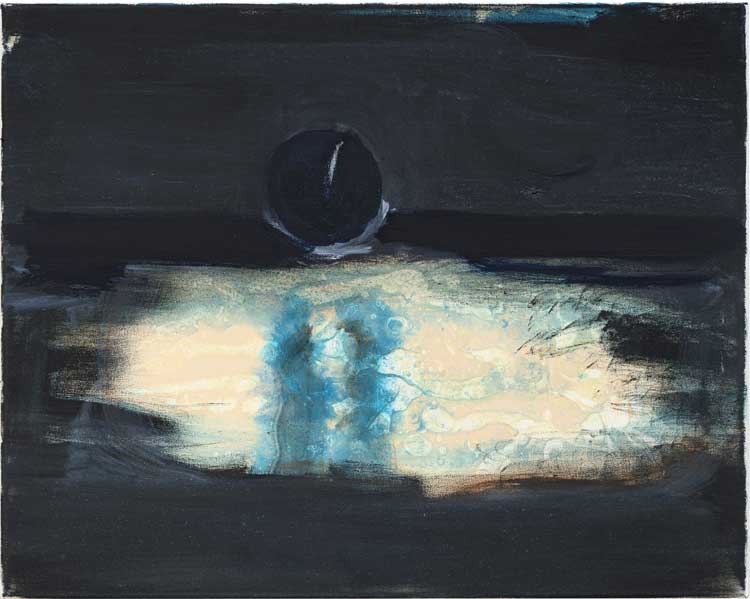
Marlene Dumas. Utøya, 2018-2023. Oil on canvas. 40 x 50 cm (15 3/4 x 19 3/4 in). Courtesy the artist and Frith Street Gallery, London. Photo: Peter Cox.
Although portraits as an aesthetic medium can feel confrontational and perhaps even literal, there is a great deal of ambiguity in Dumas’s depictions, where the fluidity of the body is consistently reimagined and questioned. Utøya (2018-23) is the most abstract piece in the exhibition, presumably named after the small island in Norway in the Tyrifjorden lake. There is no mention of why this location was chosen but given the attention in Dumas’s work to war and terror, perhaps it speaks to the mass shooting on Norwegian island of Utøya in July 2011, where 69 people died. There is a sense this painting captures the aftermath of the island and the massacre, the lingering memorialisation and haunting of its legacy.
There is a haunting beauty to her sombre palette of greys, blacks and navy, illuminated by dashes of red and yellow. Bodies contort and move, some intertwined in love and others holding each other in grief. Tombstone Lovers (2021) encompasses this, with two figures almost floating next to each other, their hands on their own genitals. There is an interesting mirroring of love and the body here, with the subdued browns and tints of blue grounding the figures in an earth-like aesthetic. Two Gods (2021) also has a coupling, with two monumental phalluses mirroring one another in deep hues of navy. Contortion reappears in other works by Dumas, where faces appear almost disfigured and otherworldly. This feeling is particularly apparent in Pareidolia (2024), which refers to the imagined perception of a patterns on images, where the face is very hard to decipher. In the absence of facial features, representation is more about abstraction and intuition, atmosphere and presence.
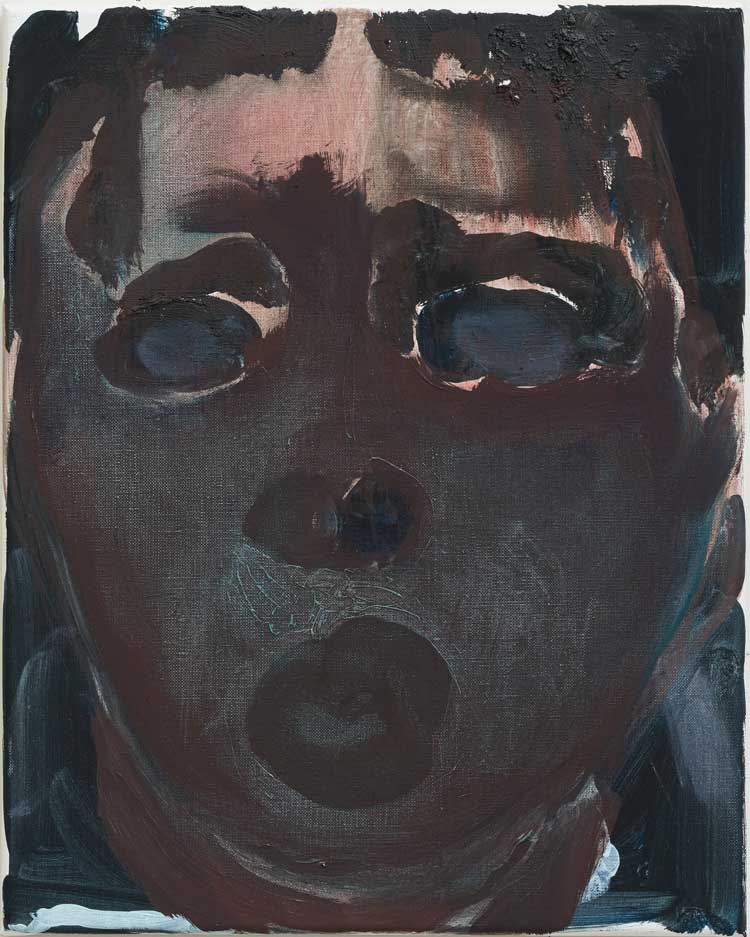
Marlene Dumas. War, 2024. Oil on canvas, 50 x 40 x 2 cm (19 3/4 x 15 3/4 x 3/4 in). Courtesy the artist and Frith Street Gallery, London. Photo: Peter Cox.
Other works in the exhibition confront the viewer head-on with piercing looks, while some figures have little facial expression at all. Yet despite these moments of heaviness, Dumas’s body of work generates a radical perspective on the human psyche and the multitude of forms it can. In Loss (2023), for instance, the closeup portrait appears to be in a state of paralysed grief, suspended in a state of sorrow. It is impossible to decipher the age of the figure, which generates a sense of universality. It is as if Dumas is commenting on how we all, at some point experience loss and it is not individual but collective. Despite being informed by these stories and histories, her process is visceral and intuitive, relying on the merging materials as her starting point. Having worked across collage, drawing, prints and installation, Dumas now primarily works with oil on canvas and ink on paper. Her process is methodological yet intuitive – she begins by loosely sketching her figures inspired by an array of source material from archives, Flemish paintings and even Polaroid photographs she has taken throughout her life. With each gesture, an emotionally charged world is born, where the afflictions of mortality, ethics and the complexities of life are distilled, each figure the bearer of intangible feelings we all reckon with. The Widow 2021-24 is a haunting portrait of a woman, whose facial expression could be interpreted as yearning for a resolution of grief.
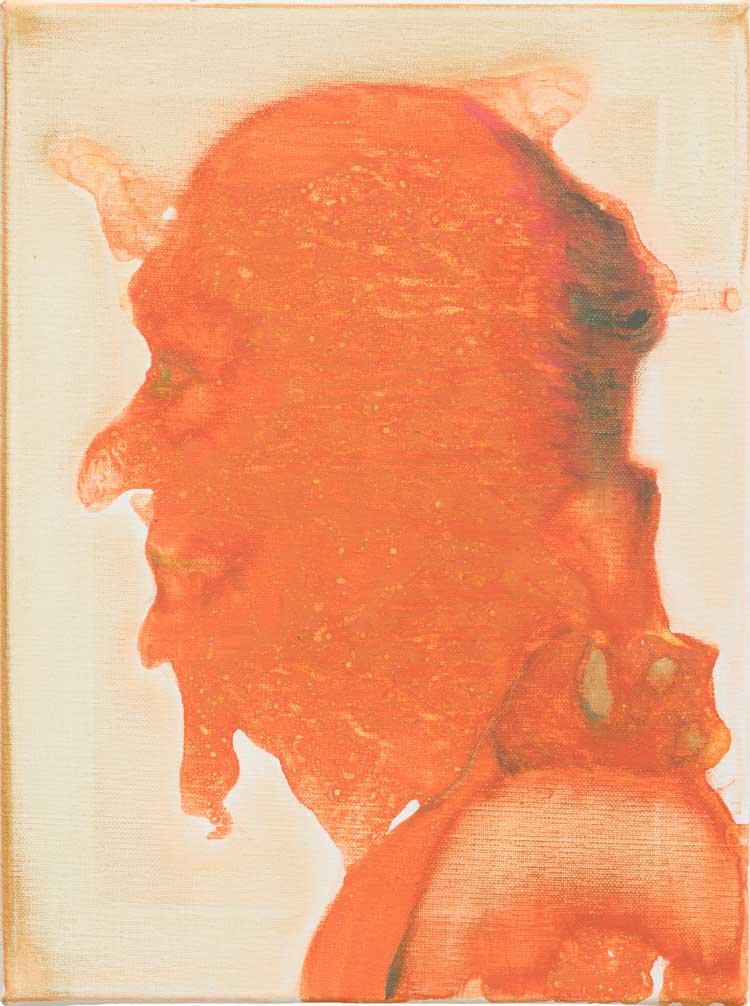
Marlene Dumas. The devil may care, 2024. Oil on canvas, 40 x 30 cm (15 3/4 x 11 3/4 in). Courtesy the artist and Frith Street Gallery, London. Photo: Peter Cox.
There is a consistency to all the works in Mourning Marsyas: despite the varying places and references, they are unified by an aesthetic sensibility of ethicality and politics. This becomes the viewer’s burden to bear through looking. Perhaps the most ethically charged artwork is Ceasefire (2024), a portrait of two figures praying, perhaps a reference to the ongoing genocide in Gaza. Among sharp hues of red and blue, the two figures are rendered as two versions of the same person – the one in the rear like the one in front’s shadow. They are separated by their expressions, one grimacing and the other with a look of terror. The viewer is reminded that Dumas’s work always acts not just to capture the emotions we all experience, but as an archive of war and disenfranchisement. By instilling the complexities of life, death, grief and war in faces and figures across different genders, ages and races, Dumas unravels the strangeness of the embodiment. It is up to us, as the viewer, to formulate how these images hold political weight in the present.